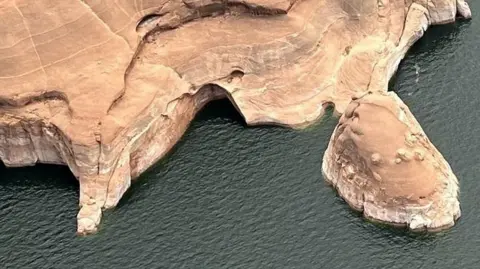Utah's famous 'Double Arch' rock collapses
 National Park Service
National Park ServiceA famous 190-million-year-old rock formation in southern Utah known as the "Double Arch" has collapsed, according to national park officials.
The popular natural phenomenon - which covered Lake Powell in the Glen Canyon National Recreation Area - crumbled last week, according to the National Park Service.
No one was injured when the rock formation fell down at the popular hiking spot.
Park rangers said changing water levels and erosion may have contributed to the collapse.
"[T]his event serves as a reminder of our responsibility and need to protect the mineral resources surrounding Lake Powell,” said Glen Canyon National Recreation Area superintendent Michelle Kerns.
The rocks that formed Double Arch - also known as the "toilet bowl" because of the large hole in the formation - consisted of fine-grained Navajo sandstone from the late Triassic to early Jurassic periods, the National Park Service said.
 National Park Service
National Park ServiceBut over time, the formation had begun to crumble and erode with wind and rain, the agency said.
Ms Kerns said the rock formation may have been influenced or damaged by "manmade interventions".
Water levels in Lake Powell have fallen steadily since 1999 due to global warming that has made the western US hotter and drier, according to NASA. Water levels rose this year after reaching historic lows in 2023, but have not fully rebounded to 1999, when the lake was near capacity.
The rock formation was a popular hiking destination. In 2023, over 5 million people visited the Glen Canyon National Recreation Area, which spans 1.25 million acres in Utah and Arizona.
Several people took to social media to mourn the loss of the famed arches. One user posted a video of the rock formation hovering above Lake Powell just a day before the collapse. Another said she had a picture of her mother floating below the rock in an inner tube from 1969.
"Sad to see it go," she posted.
Utah's parks are home to many arch-like rock formations, including in Arches and Zion National Park.
